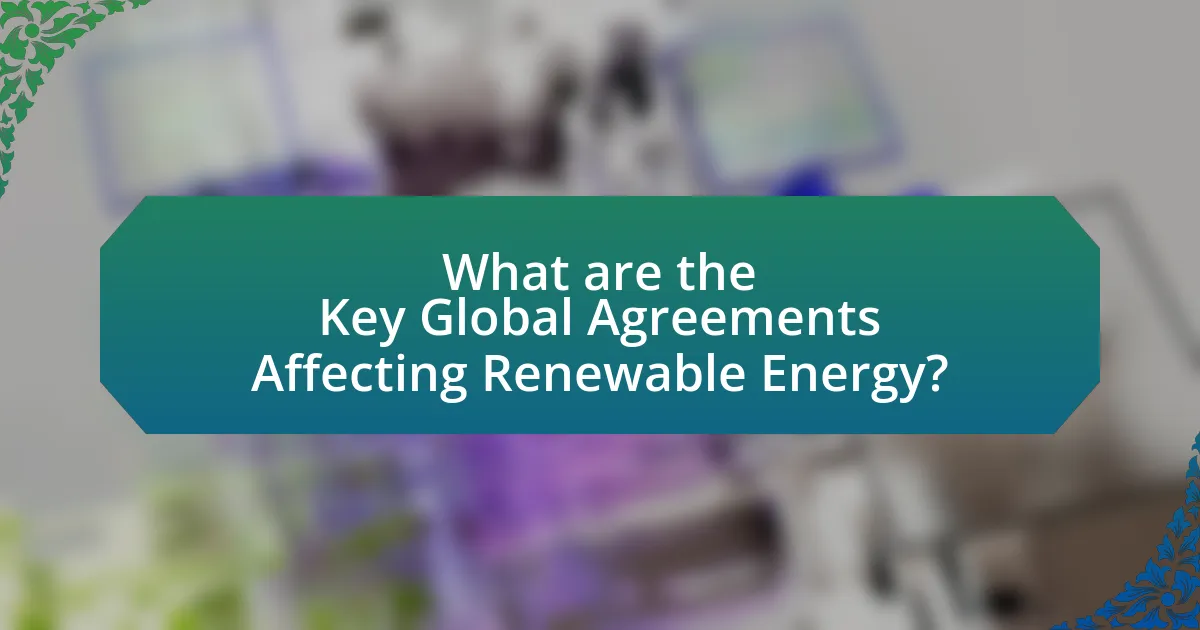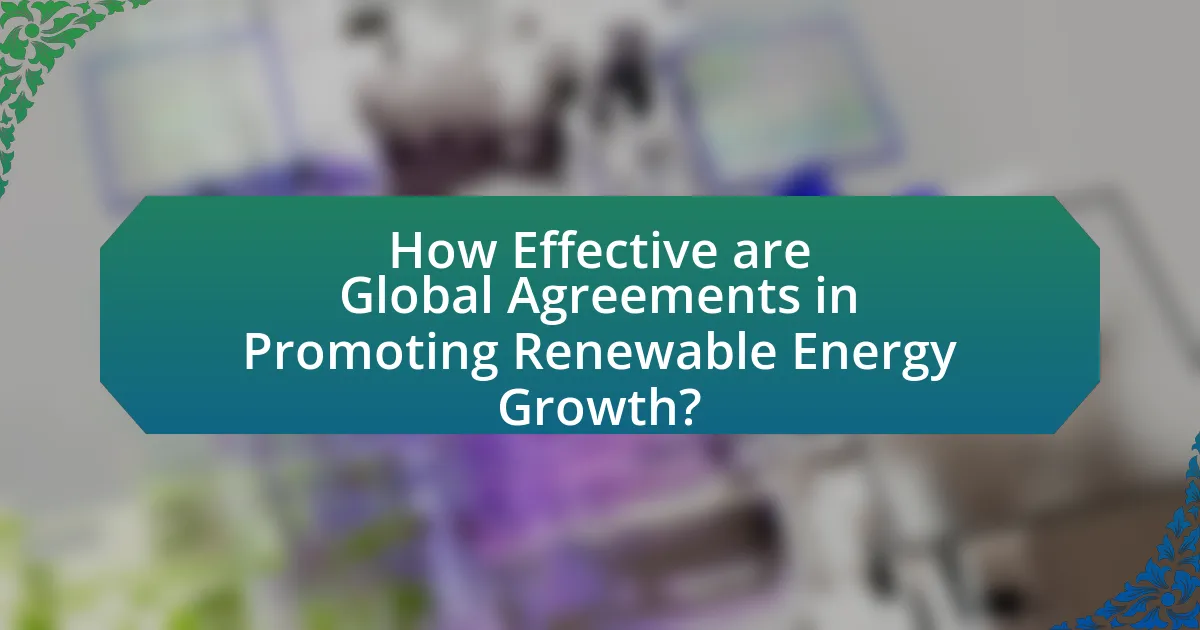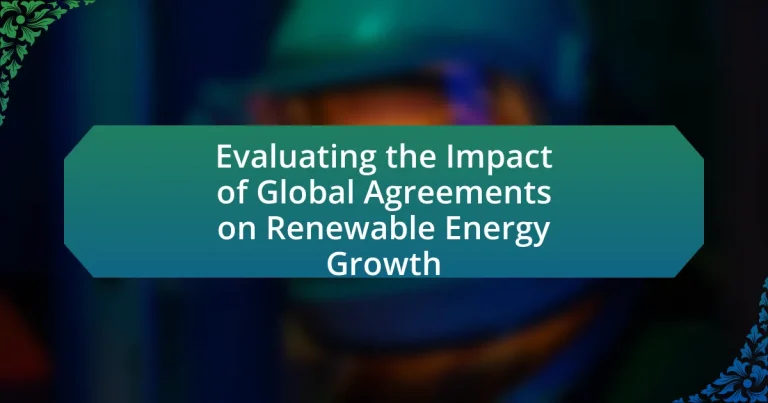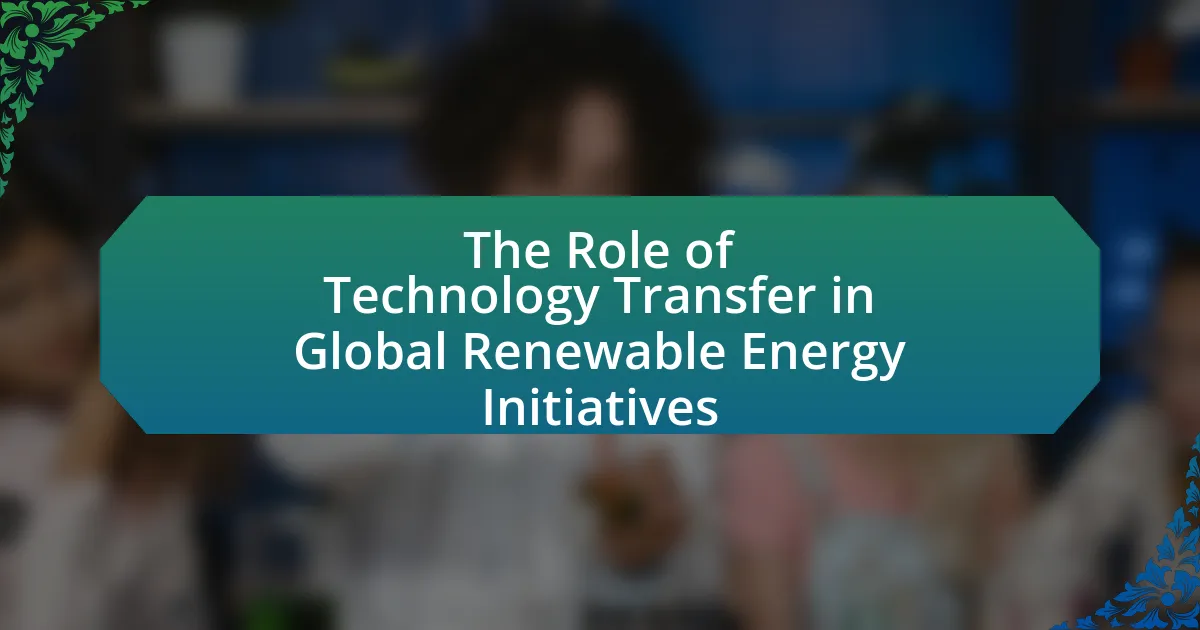Global agreements, such as the Paris Agreement and the United Nations Sustainable Development Goals, play a pivotal role in promoting renewable energy growth by establishing binding commitments for countries to reduce greenhouse gas emissions and transition to sustainable energy sources. These agreements influence national policies, drive investments in renewable technologies, and foster international cooperation, resulting in significant increases in renewable energy capacity. The article evaluates the effectiveness of these global agreements, examining their impact on renewable energy adoption, technological innovation, and economic benefits, while also highlighting best practices and challenges in assessing their outcomes. Key case studies illustrate how specific countries have leveraged these agreements to enhance their renewable energy sectors, demonstrating the importance of collaborative efforts in achieving sustainable energy goals.

What are Global Agreements and Their Role in Renewable Energy Growth?
Global agreements are formal treaties or accords between countries aimed at addressing global issues, including climate change and renewable energy development. These agreements, such as the Paris Agreement, play a crucial role in promoting renewable energy growth by establishing binding commitments for nations to reduce greenhouse gas emissions and transition to sustainable energy sources. For instance, the Paris Agreement, adopted in 2015, set a target to limit global warming to well below 2 degrees Celsius, encouraging countries to invest in renewable technologies and reduce reliance on fossil fuels. This collective commitment fosters international cooperation, mobilizes financial resources, and drives innovation in renewable energy sectors, ultimately accelerating the transition to a low-carbon economy.
How do global agreements influence renewable energy policies?
Global agreements significantly influence renewable energy policies by establishing binding commitments and frameworks that guide national actions. For instance, the Paris Agreement, adopted in 2015, compels countries to set and achieve specific greenhouse gas reduction targets, which often necessitates a shift towards renewable energy sources. This international accord has led to increased investments in solar and wind energy, as nations strive to meet their climate goals. Additionally, global agreements foster collaboration and knowledge sharing among countries, enhancing technological advancements and best practices in renewable energy deployment. The influence of these agreements is evident in the growing number of countries implementing policies that promote renewable energy, as seen in the rise of renewable energy capacity worldwide, which reached over 2,800 gigawatts in 2020, according to the International Renewable Energy Agency.
What types of global agreements exist that impact renewable energy?
Global agreements that impact renewable energy include international treaties, protocols, and frameworks aimed at promoting sustainable energy practices. Key examples are the Paris Agreement, which commits countries to limit global warming and encourages the transition to renewable energy sources, and the United Nations Sustainable Development Goals (SDGs), particularly Goal 7, which aims to ensure access to affordable, reliable, sustainable, and modern energy for all. Additionally, the Kyoto Protocol established legally binding obligations for developed countries to reduce greenhouse gas emissions, indirectly promoting renewable energy adoption. These agreements collectively influence national policies and investments in renewable energy technologies, driving global efforts toward a sustainable energy future.
How do these agreements set targets for renewable energy adoption?
Agreements set targets for renewable energy adoption by establishing specific, measurable goals that countries commit to achieving within defined timeframes. For instance, the Paris Agreement aims to limit global warming to well below 2 degrees Celsius, which necessitates a significant increase in renewable energy sources to reduce greenhouse gas emissions. Additionally, many agreements include nationally determined contributions (NDCs) that outline individual countries’ commitments to increase their renewable energy capacity, often specifying percentage increases or total megawatt targets by certain years. These commitments are supported by frameworks for reporting progress and accountability, ensuring that countries are held responsible for meeting their renewable energy targets.
Why are global agreements essential for renewable energy development?
Global agreements are essential for renewable energy development because they establish a unified framework for countries to collaborate on reducing greenhouse gas emissions and promoting sustainable energy practices. These agreements, such as the Paris Agreement, set binding targets that encourage nations to invest in renewable technologies, share best practices, and mobilize financial resources. For instance, the International Renewable Energy Agency reported that global renewable energy capacity reached 2,799 gigawatts in 2019, largely driven by international cooperation and commitments made through such agreements. This collaborative approach not only accelerates technological advancements but also fosters a global market for renewable energy, making it more accessible and affordable.
What are the economic benefits of global agreements on renewable energy?
Global agreements on renewable energy provide significant economic benefits, including job creation, investment attraction, and cost reductions in energy production. For instance, the International Renewable Energy Agency reported that the renewable energy sector employed over 11 million people globally in 2018, with projections indicating continued growth as countries commit to sustainable energy goals. Additionally, these agreements foster international collaboration, leading to increased investments in clean technologies; the Global Wind Energy Council noted that global investments in renewable energy reached $282.2 billion in 2019. Furthermore, the cost of renewable energy technologies, such as solar and wind, has decreased dramatically, with the International Energy Agency stating that the cost of solar photovoltaic systems fell by 82% between 2010 and 2019, making renewable energy more competitive with fossil fuels.
How do global agreements promote technological innovation in renewable energy?
Global agreements promote technological innovation in renewable energy by establishing frameworks that encourage collaboration, investment, and knowledge sharing among nations. These agreements, such as the Paris Agreement, set binding targets for emissions reductions, which incentivize countries to develop and adopt new technologies to meet their commitments. For instance, the commitment to limit global warming has led to increased funding for research and development in solar, wind, and other renewable technologies, as countries seek to transition away from fossil fuels. Additionally, global agreements facilitate the sharing of best practices and technologies, enabling countries to learn from each other’s successes and failures, thereby accelerating innovation. The International Renewable Energy Agency (IRENA) reported that global investment in renewable energy reached $282.2 billion in 2019, driven in part by the commitments made under international agreements, highlighting the direct correlation between these agreements and technological advancements in the sector.

What are the Key Global Agreements Affecting Renewable Energy?
The key global agreements affecting renewable energy include the Paris Agreement, the United Nations Framework Convention on Climate Change (UNFCCC), and the Sustainable Development Goals (SDGs). The Paris Agreement, adopted in 2015, aims to limit global warming to well below 2 degrees Celsius, promoting the transition to renewable energy sources among its signatories. The UNFCCC, established in 1992, provides a framework for international cooperation on climate change, encouraging countries to adopt policies that support renewable energy development. Additionally, the SDGs, particularly Goal 7, emphasize the importance of ensuring access to affordable, reliable, sustainable, and modern energy for all, which inherently supports the growth of renewable energy initiatives. These agreements collectively drive national policies and international collaboration towards increasing the share of renewable energy in the global energy mix.
What is the Paris Agreement and its significance for renewable energy?
The Paris Agreement is an international treaty adopted in 2015 aimed at combating climate change by limiting global warming to well below 2 degrees Celsius above pre-industrial levels. Its significance for renewable energy lies in its commitment to reducing greenhouse gas emissions, which drives countries to transition from fossil fuels to renewable energy sources. For instance, the agreement encourages nations to set and achieve nationally determined contributions (NDCs) that often include increasing the share of renewables in their energy mix. As of 2021, over 190 countries have ratified the agreement, collectively representing a significant push towards renewable energy investments, with global renewable energy capacity growing by 10.3% in 2020, according to the International Renewable Energy Agency (IRENA).
How does the Paris Agreement set emission reduction targets?
The Paris Agreement sets emission reduction targets through a framework that encourages countries to establish their own nationally determined contributions (NDCs). Each participating country submits its NDC, which outlines specific commitments to reduce greenhouse gas emissions, reflecting its national circumstances and capabilities. The agreement emphasizes a bottom-up approach, allowing countries to increase their ambition over time, with a goal of limiting global warming to well below 2 degrees Celsius above pre-industrial levels, aiming for 1.5 degrees Celsius. This structure is supported by a global stocktake every five years to assess collective progress and encourage enhanced commitments.
What role does the Paris Agreement play in financing renewable energy projects?
The Paris Agreement plays a crucial role in financing renewable energy projects by establishing a framework that encourages investment in sustainable energy solutions. Specifically, it sets binding commitments for countries to reduce greenhouse gas emissions, which drives the demand for renewable energy technologies. The agreement also promotes financial mechanisms, such as the Green Climate Fund, which aims to mobilize $100 billion annually by 2020 to support developing countries in their transition to low-emission and climate-resilient development, thereby directly facilitating funding for renewable energy initiatives. Additionally, the commitment to limit global warming to well below 2 degrees Celsius creates a favorable investment climate, as it signals long-term market stability and growth potential for renewable energy sectors.
What other international agreements support renewable energy initiatives?
The Paris Agreement is a key international agreement that supports renewable energy initiatives by committing countries to limit global warming and promote sustainable energy practices. This agreement, adopted in 2015, encourages nations to enhance their climate actions, which often includes transitioning to renewable energy sources. Additionally, the United Nations Sustainable Development Goals (SDGs), particularly Goal 7, aim to ensure access to affordable, reliable, sustainable, and modern energy for all, further promoting renewable energy development. The Clean Development Mechanism (CDM) under the Kyoto Protocol also incentivizes investment in renewable energy projects in developing countries, facilitating technology transfer and capacity building. These agreements collectively foster a global framework that prioritizes renewable energy as a critical component of sustainable development and climate action.
How does the United Nations Sustainable Development Goals relate to renewable energy?
The United Nations Sustainable Development Goals (SDGs) directly relate to renewable energy through Goal 7, which aims to ensure access to affordable, reliable, sustainable, and modern energy for all. This goal emphasizes the importance of increasing the share of renewable energy in the global energy mix, promoting energy efficiency, and enhancing international cooperation to facilitate access to clean energy research and technology. According to the International Renewable Energy Agency, achieving SDG 7 is crucial for addressing climate change and fostering sustainable economic growth, as renewable energy sources can significantly reduce greenhouse gas emissions and provide energy security.
What impact do regional agreements have on renewable energy growth?
Regional agreements significantly accelerate renewable energy growth by fostering collaboration, sharing best practices, and providing financial incentives among member states. For instance, the European Union’s Renewable Energy Directive has led to a collective target of 32% renewable energy by 2030, driving investments and technological advancements across member countries. Additionally, regional agreements often facilitate cross-border energy trade, enhancing energy security and enabling countries to meet their renewable energy goals more efficiently. This collaborative approach has been shown to increase renewable energy capacity, as evidenced by the International Renewable Energy Agency’s report indicating that regions with strong agreements see higher rates of renewable energy deployment compared to those without such frameworks.

How Effective are Global Agreements in Promoting Renewable Energy Growth?
Global agreements are highly effective in promoting renewable energy growth, as evidenced by the significant increase in renewable energy investments and capacity following international accords like the Paris Agreement. For instance, the International Renewable Energy Agency reported that global renewable energy capacity reached 2,799 gigawatts in 2019, largely driven by commitments made under such agreements. Additionally, countries that ratified the Paris Agreement have collectively pledged to reduce greenhouse gas emissions, which has spurred national policies and financial incentives aimed at expanding renewable energy sources. This correlation between global agreements and renewable energy growth is further supported by research from the World Resources Institute, which indicates that nations with binding commitments tend to experience faster transitions to renewable energy technologies.
What metrics are used to evaluate the effectiveness of global agreements?
Metrics used to evaluate the effectiveness of global agreements include emission reduction targets, compliance rates, and financial contributions. Emission reduction targets assess the extent to which countries meet their commitments to lower greenhouse gas emissions, while compliance rates measure adherence to the agreed-upon regulations and timelines. Financial contributions evaluate the monetary support provided by developed nations to assist developing countries in achieving their renewable energy goals. These metrics are essential for determining the overall success and impact of global agreements on renewable energy growth, as evidenced by the commitments made under the Paris Agreement, where countries set specific targets to limit global warming and report on their progress.
How do we measure the increase in renewable energy capacity due to these agreements?
The increase in renewable energy capacity due to agreements is measured by tracking the installed capacity of renewable energy sources, such as solar, wind, and hydroelectric power, before and after the agreements are enacted. This measurement involves collecting data from energy regulatory bodies and industry reports that quantify the megawatts (MW) added to the grid as a direct result of these agreements. For instance, the International Renewable Energy Agency (IRENA) reported that global renewable energy capacity reached 2,799 GW in 2020, reflecting significant growth attributed to international climate agreements and national policies aimed at increasing renewable energy investments.
What are the challenges in assessing the impact of global agreements?
Assessing the impact of global agreements faces several challenges, primarily due to the complexity of measuring outcomes across diverse contexts. One significant challenge is the difficulty in establishing clear causal relationships between agreements and specific outcomes, as multiple factors can influence renewable energy growth simultaneously. For instance, the adoption of renewable technologies may be affected by local policies, economic conditions, and technological advancements, making it hard to isolate the effects of global agreements. Additionally, data availability and quality can hinder assessments; many countries lack comprehensive data on energy production and consumption, which complicates the evaluation process. Furthermore, differing interpretations of agreement commitments can lead to inconsistencies in implementation and reporting, further obscuring the true impact of these agreements on renewable energy growth.
What case studies illustrate the impact of global agreements on renewable energy?
Case studies illustrating the impact of global agreements on renewable energy include the Paris Agreement and the European Union’s Renewable Energy Directive. The Paris Agreement, adopted in 2015, has led to significant commitments from countries to reduce greenhouse gas emissions, resulting in increased investments in renewable energy technologies. For instance, countries like Germany and Denmark have ramped up their wind energy capacity, with Germany generating over 40% of its electricity from renewables in 2020, largely due to commitments made under this agreement.
Similarly, the European Union’s Renewable Energy Directive has set binding targets for member states, leading to a collective increase in renewable energy share to 18% by 2020, with countries like Sweden achieving over 54% of their energy from renewable sources. These case studies demonstrate how global agreements can drive national policies and investments in renewable energy, fostering growth in the sector.
How have specific countries benefited from global agreements in renewable energy?
Countries such as Germany and China have significantly benefited from global agreements in renewable energy by enhancing their technological advancements and increasing investment in sustainable energy sectors. Germany, through the Paris Agreement, has accelerated its transition to renewable sources, achieving a 42% share of renewables in electricity generation by 2019, which has fostered job creation in green technologies. Similarly, China has leveraged its participation in international agreements to become the world’s largest producer of solar panels, with a reported 70% of global solar manufacturing capacity in 2020, leading to substantial economic growth and energy security. These examples illustrate how global agreements facilitate technological innovation and economic opportunities in renewable energy sectors.
What lessons can be learned from successful implementations of these agreements?
Successful implementations of global agreements on renewable energy growth demonstrate the importance of strong political commitment and stakeholder engagement. For instance, the Paris Agreement has shown that nations can achieve significant emissions reductions when they collaborate and set clear, binding targets. Evidence from countries like Denmark, which has committed to 50% renewable energy by 2030, illustrates that comprehensive policy frameworks and public support can drive substantial investment in renewable technologies. Additionally, successful case studies highlight the need for adaptive management strategies that allow for flexibility in response to changing circumstances, as seen in Germany’s Energiewende initiative, which has effectively integrated renewable energy into its national grid while addressing challenges. These lessons underscore the critical role of collaboration, clear objectives, and adaptive policies in fostering renewable energy growth through global agreements.
What best practices can enhance the effectiveness of global agreements on renewable energy?
Best practices that can enhance the effectiveness of global agreements on renewable energy include establishing clear, measurable targets, fostering international collaboration, and ensuring financial support for developing countries. Clear targets, such as the Paris Agreement’s goal to limit global warming to well below 2 degrees Celsius, provide a framework for accountability and progress tracking. International collaboration, exemplified by initiatives like the International Renewable Energy Agency, facilitates knowledge sharing and technology transfer among nations. Financial support mechanisms, such as the Green Climate Fund, are crucial for enabling developing countries to invest in renewable energy infrastructure, thereby promoting equitable participation in global efforts. These practices collectively strengthen the implementation and impact of global agreements on renewable energy.




